
The Scandinavian America Line (Skandinavien-Amerika-Linien) was founded in 1898, when Det Forenede Dampskibs-Selskap (DFDS) took over the steamship company Thingvalla Line. The passenger and freight service between Scandinavia and New York City was operated under the name Scandinavian America Line until 1935.
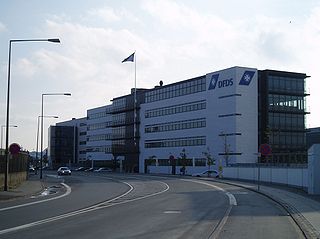
DFDS is a Danish international shipping and logistics company. The company's name is an abbreviation of Det Forenede Dampskibs-Selskab. DFDS was founded in 1866, when C.F. Tietgen merged the three biggest Danish steamship companies of that day.

MS Crown Seaways is a cruiseferry operated by DFDS Seaways on a route connecting Copenhagen & Frederikshavn in Denmark to Oslo, Norway. The ship was built in 1994 by Brodosplit in Split, Croatia. She was originally ordered by Euroway and was to be called Frans Kockum but never sailed under that name. The ship was also temporarily renamed Thomas Mann during construction. She first sailed under the name Crown of Scandinavia.
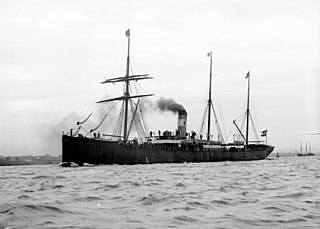
SSNorge was a transatlantic ocean liner that was launched in 1881 in Scotland, and lost in 1904 off Rockall with great loss of life. Her final voyage was from Copenhagen, Kristiania and Kristiansand, bound for New York, carrying passengers many of whom were emigrants. It was the biggest civilian maritime disaster in the Atlantic Ocean until the sinking of Titanic eight years later, and is still the largest loss of life from a Danish merchant ship.

Carl Frederik Tietgen was a Danish financier and industrialist. He played an important role in the industrialisation of Denmark as the founder of numerous prominent Danish companies, many of which are still in operation today. Tietgen notably formed conglomerates, thus several of Tietgen's companies attained monopoly-like status, cementing their durability.

DFDS Seaways is a Danish shipping company that operates passenger and freight services across northern Europe. Following the acquisition of Norfolkline in 2010, DFDS restructured its other shipping divisions into the previously passenger-only operation of DFDS Seaways.

The Tor Line was a freight shipping company. Together with its subsidiaries, the Tor Line operated a fleet of approximately 65 ro-ro, ro-pax and lo-lo ships, primarily on the North and Baltic Seas. It was ultimately purchased by Denmark-based DFDS, which renamed it DFDS Tor Line, and it operated as a freight-carrying division of DFDS along with DFDS Lisco, DFDS Lys Line and DFDS Container Line before retiring the brand.

MS Moby Otta is a cruiseferry, currently owned by the Italy-based shipping company Moby Lines and operated on their Genoa–Olbia service. She was built in 1976 by Flender Werke, Lübeck, West Germany as MS Tor Scandinavia for Tor Line. Between 1991 and 2006 she sailed as MS Princess of Scandinavia.
Det Norske Luftfartselskap A/S or DNL, trading internationally as Norwegian Air Lines, was an airline and flag carrier of Norway. Founded in 1927, it operated domestic and international routes from 1935 to 1941 and from 1946 to 1951. It became one of the three founders of Scandinavian Airlines System (SAS) and became one of its three holding companies from 1951, with a 28% stake and listed on the Oslo Stock Exchange. DNL was renamed SAS Norge ASA in 1996 and was merged in 2001 to create the SAS Group.

SS Dwinsk was a transatlantic ocean liner that was launched in Ireland in 1897 as Rotterdam, renamed C. F. Tietgen in 1906, and renamed Dwinsk in 1913. A U-boat sank her in 1918, with the loss of 23 lives. The ship was built for Holland America Line, but was successively owned by Scandinavian America Line and Russian American Line, and after the Russian Revolution she was managed by Cunard Line.

Sankt Annæ Plads is a public square which marks the border between the Nyhavn area and Frederiksstaden neighborhoods of central Copenhagen, Denmark. It is a long narrow rectangle which extends inland from the waterfront, at a point just north of the Royal Danish Playhouse at the base of the Kvæsthus Pier, now known as Ofelia Plads, until it meets Bredgade. A major renovation of the square was completed in 2016.The Garrison Church is located on the south side of the square. Amaliegade, one of the two axes on which Frederiksstaden is centered, extends from the square.

Amaliehaven is a small park located between Amalienborg Palace and the waterfront in the Frederiksstaden neighbourhood of central Copenhagen, Denmark. It was established in 1983 as a gift from the A.P. Møller and the Chastine McKinney Møller Foundation. The park is part of the so-called Frederiksgade axis, the shorter but more distinctive of the two axes on which Frederiksstaden is centred.

Larsens Plads is a waterfront in Copenhagen, Denmark, which runs along the Zealand side of the main harbour from the Nyhavn canal in the south to the Nordre Toldbod area just south of Langelinie to the north. The name refers to a shipyard which used to occupy the grounds but is now more associated with emigration to America after it became a major hub for trans-Atlantic traffic later in the century. It is dominated by Amalienborg Palace with the Amalie Garden and a number of late 18th-century warehouses which have been converted to other uses. The buildings facing the waterfront have their address on the parallel street Toldbodgade.
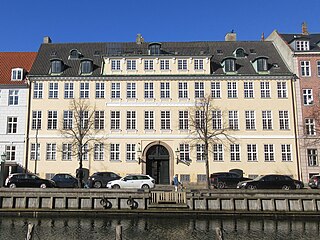
The Heering House is a Neoclassical house overlooking Christianshavn Canal in the Christianshavn neighbourhood of Copenhagen, Denmark. It takes its name from Peter Frederik Suhm Heering (1792-1875) who owned it from 1838 until his death in 1875 and it continued to serve as headquarters for his company, Peter Heering, until 1977. The building is now home to the Nordea Foundation and a museum dedicated to banks and saving banks, as well as six residences available to foreign researchers and specialists.
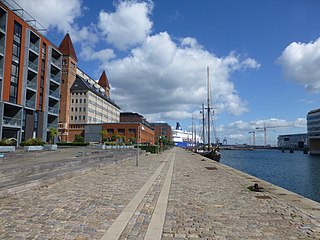
Amerikakaj is a 700 metre long quay along the west side of the Søndre Frihavn dock in Copenhagen, Denmark. The name commemorates the transatlantic passenger ships of the Scandinavian America Line which used to berth along the quay during the first half of the 20th century. Today DFDS's ferries to Oslo berth at its north end.
The United Kingdom to Norway ferry service was a route connecting Newcastle in England with Stavanger, Bergen, and Haugesund in Norway. It existed for over 140 years until 2008, when it was last operated by DFDS Seaways. Between 2010 and 2015 there were attempts by various companies to relaunch service.
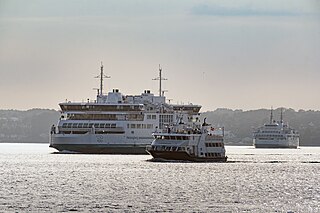
The Helsingør–Helsingborg ferry route is a shipping route connecting Helsingør (Elsinore), Denmark and Helsingborg, Sweden across the northern, and narrowest part of the Øresund. Due to the short distance, which is less than 3 nautical miles, is it one of the world's busiest international car ferry routes, with around 70 daily departures from each harbour. The oldest-known written mention of the route dates to the German traveller Adam of Bremen in the 11th century, but it has likely been in use much longer. Before 1658, the route was a domestic Danish route. For several centuries, the route has been run regularly by various Danish shipping lines. Its significance grew during the 1950s, but since the inauguration of the Øresund Bridge in 2000, at the southern end of the Øresund, it has lost some significance but remains as one of the world's most important ferry routes, particularly as a cheaper alternative to the bridge tolls. Since 1952, passports have not been required for citizens of the Nordic Passport Union countries. Since 2001, when both countries became members of the Schengen Area, passports are not needed for anyone.

LB (car ferries) or locally simply LB was a car and lorry ferry line that between 1955 and 1981 operated on the HH Ferry route between Helsingør (Elsinore), Zealand, Denmark and Helsingborg, Scania, Sweden. They were the first operator on this route to challenge the informal monopoly which DSB had enjoyed ever since 1888. Since 1630, competition at the route had only occurred between 1836 and 1840. The route had further been operated by the Danish National railways with train ferries since 1892, and since 1931 with a 50-50 support deal also with the National Swedish railway. Until LB challenged the informal monopoly.

The Battle of Eckernförde was a Danish naval assault on Schleswig. The Danes were defeated and two of their ships were lost with the surviving crew being detained.

MS Moby Drea is a cruiseferry, currently owned by the Italy-based shipping company Moby Lines and operated on their Genoa–Olbia service. It was built in 1975 by Flender Werke, Lübeck, West Germany as MS Tor Britannia for Tor Line. Between 1991 and 2003 it sailed as MS Prince of Scandinavia.



















